#chalcedony replaced fossil
Explore tagged Tumblr posts
Text
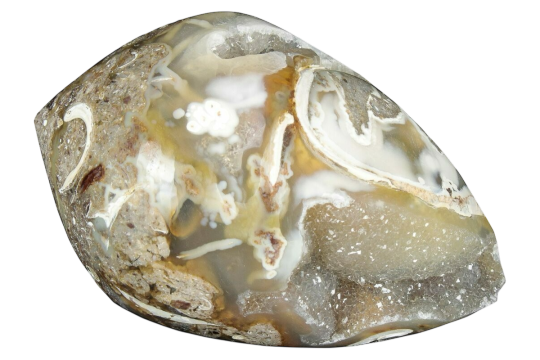
1.55" Chalcedony Replaced Gastropod With Sparkly Quartz - India
#cretaceous#chalcedony#gastropod#gastropods#chalcedony replaced fossil#sparkly#fossil#sparkly quartz#gemstone#crystal#fossils#gem#png#transparent#paleontology#geology
38 notes
·
View notes
Text





Palm Root Stone, stone of grounding
🤎 Palm root stone, often referred to as petrified palm root, is a type of fossilized wood formed from ancient palm trees. Over millions of years, organic materials in the palm wood are replaced with minerals like quartz, calcite, or chalcedony, preserving the structure of the original wood. This process creates a stone that retains the texture and appearance of the palm root but is now a durable, mineral rich material.
🖤 It typically has earthy tones like beige, brown, black, and white, often with intricate patterns resembling wood grain or roots.
🤎 Palm root stone is found in areas where palm trees thrived millions of years ago. Common sources include regions in Indonesia, India, and the United States.
🖤 Palm root stone is believed to anchor the user to the Earth, fostering a sense of stability and balance. It is often used during meditation to center the mind and maintain focus.
🤎 As a fossilized material, it symbolizes transformation and growth, helping individuals adapt to life changes and overcome challenges. It inspires patience and perseverance by reminding the user of the slow, natural processes that lead to beautiful outcomes.
🖤 Palm root stone is associated with ancient knowledge and the Earth’s memories, making it a tool for connecting with ancestral energies or wisdom. It can be used to help unlock past life memories and lessons.
🤎 Many believe palm root stone creates a protective shield, guarding against negative energies and emotional instability. It can also provide a sense of safety during times of uncertainty or transition.
🖤 Palm root stone is often used to balance and activate the root chakra, the energy center responsible for grounding, survival instincts, and physical well being. This promotes a deeper connection to the physical world and a sense of security.
🤎 It is used in crystal grids, meditation, and energy work to align spiritual energy with physical reality. It's calming vibrations make it suitable for mindfulness practices and stress relief.
🖤 As a symbol of stability and growth, it helps in manifesting goals and intentions, especially those related to long term projects or personal development.
#aesthetic#nature#photography#nature photography#moodboard#naturecore#crystalcore#crystals#gem stones
25 notes
·
View notes
Text
FOSSIL FRIDAY
Today we will talk about Petrified Wood!
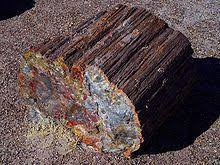
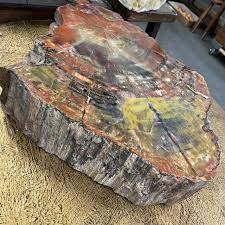
One of the most common fossils, petrified wood is is tree or tree-like wood that has either been fossilized through replacement or permineralization. Usually, the organic material is replicated by silica (quartz or it's microcrystalline forms opal or chalcedony).
Petrified wood forms when woody plants are buried in saturated sediments with dissolved minerals in solution. The lack of oxygen slows decay and allows fossilization to occur.

Below are petrified wood and cycad specimens I have collected over the years from various localities I have worked at. All come from Late Jurassic sites.
The first is from the Salt Wash Member of the Morrison Formation in northwestern Colorado. It has been replaced by silica, most likely the microcrystalline quartz form, chalcedony.

The second is from the same location and has definitely been replaced by chalcedony. In this case, it looks to be the "flint" variety.
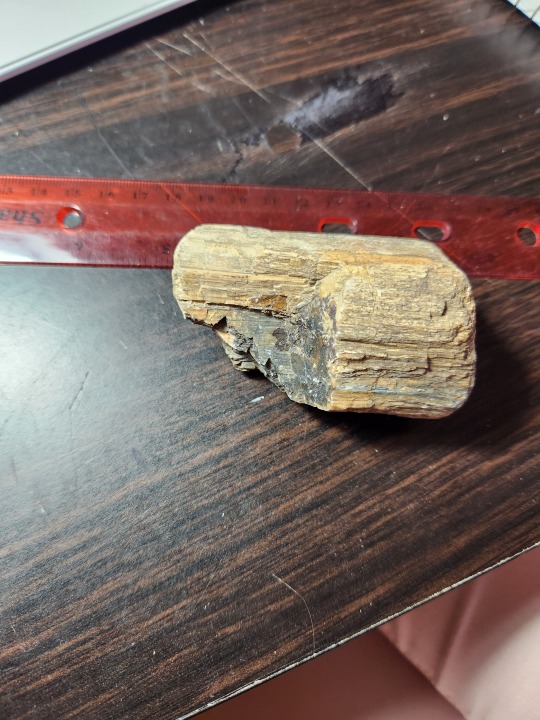
The third photo contains pieces of of wood from the Late Jurassic Swift Formation in northwest central Montana (It's a huge state. I need to be that weirdly specific). These are partially petrified and partially coalified. They still retain some of the original organic material which leaves a black residue on the fingers.
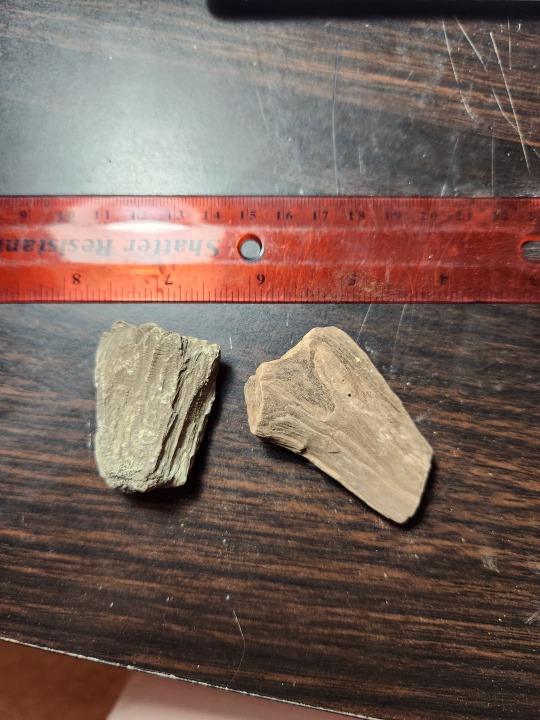

The fourth photograph are pieces that came from the Brushy Basin Member of the Morrison Formation in the San Rafael Swell of Utah. These have been permineralized by quartz.

Finally, the last two show cycads, a type of woody plant that was a prominent part of the Mesozoic woodlands and prairies. These specimens came from the same Salt Wash site as the first two tree specimens. These have also been replaced by chalcedony.
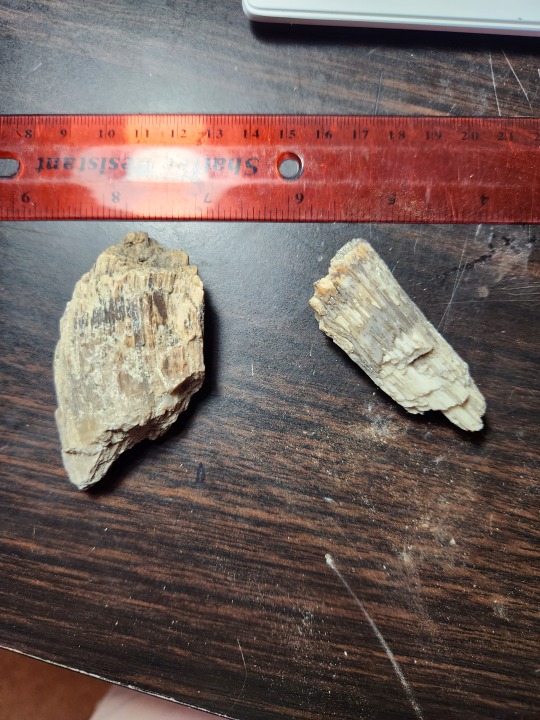

101 notes
·
View notes
Text




Petrified wood
Zodiac - Leo
Vibration - Master Number 77
Typical colours - Browns
Petrified Wood is also known as “Agatised Wood”.
It is the name given to fossil wood where the replacement of the wood is by Chalcedony.
Petrified Wood is a stone of transformation. It assists one to advance to ones highest chosen level. Helps to make one feel safe and secure, calming down survival based fears. Petrified Wood assists in setting a pace and staying with that pace all day long. It is useful for bringing patience to those in a process of slow inner transformation, and for bringing that change to fruition. Petrified Wood strengthens one’s backbone, physically and in terms of self-will.
Stone of good fortune, longevity and security
#petrified wood#crystals#spiritual#meditation#becolourful#gemstone#metaphysical#crystalhealing#yoga#fashion#style
12 notes
·
View notes
Text
ok so my lovely mutual @icarrymany dared me to post proof of my rock/min collection so this is his fault >:)
im not gonna go into depth on all of the samples bc 1. i dont remember the details on all of them lol and 2. it would take. forever
so instead ill talk a little abt one or two of them per section :3
first up: tumbled minerals!
i have a bunch more of these but after becoming a geology student they kind of piss me off bc raw minerals often look way cooler and tumbling removes the crystal habit (and also makes them harder for me to identify hgjhfd)



first image, from left clockwise: (possibly) blue lace agate, chrysocolla. labradorite, snowflake obsidian, moss agate, brown agate, and two samples of tigers eye
2nd image: up close picture of one of the tigers eye crystals, showing its lighter banding
3rd image: up close picture of the labradorite from a different angle, showing its pale green luster
my absolute favorite mineral ever is labradorite also!! i think its luster is gorgeous and ive heard it represents transformation and change, and i first got this sample back when i had just come out as trans :)
i dont really have a lot to say abt these unfortunately lol
anyway. next is fossils!!




1st image, clockwise from bottom left: trilobite cast fossil, tumbled stromatolite, dinosaur bone (? got this one at a mineral stall and the dude said it was a dino bone, didnt think to ask details lol), plant fossil, coral fossil, assorted fossil molds (mold as in taking the shape of something, not spores) in wackestone, mosasaurus tooth, crocodile (?) tooth, 2 ammonites, a turtle scute, a crinoid stem, and a (broken) orthoceras
2nd image: up close pic of the assorted fossil molds, which include horn corals (circular with ridges toward center, hole in middle), crinoid stems (cylindrical with ridges perpendicular to long sides), and shells
3rd image: up close pic of larger ammonite, with iridescent luster due to aragonite (a polymorph of calcite) replacing the calcite of the shell
4th image: up close pic of dubious tooth. i found this on a field trip about a year ago while looking for shark teeth. this is not a shark tooth. idk what it is. i think it might be from a crocodile but i havent been able to fully identify it lol
now.... raw minerals!!!!!






1st image, clockwise from left: moss agate, talc, serpentinite (this one is a metamorphic rock but i accidentally put it with the minerals and dont want to retake the pics. other geologists you may come kill me), two calcite samples, and a tiny topaz @ramones2 gave me
2nd pic: close up on the topaz crystal, which is light orange (if u leave these in the sun they get bleached and lose their color </3)
3rd pic: close up on one of the calcites. its crystals are a bit more squared and close-knit than the next calcite, and appear more white in color. there are also some small purple fluorite crystals mixed in. i traded with a classmate for this one lol
4th pic: close up on the other calcite. this ones crystals are more rounded and transparent.
5th pic: close up on the serpentinite. serpentinite is metamorphosed from peridotite, which makes up the earth's mantle (if youve ever heard that the mantle is actually green, that is true!! the green comes from olivine mostly, but also some pyroxenes). when peridotite is lifted up to the surface and comes into contact with water, olivine gets very unhappy and serpentinizes, or hydrothermally metamorphoses (water + some heat + olivine = cool as fuck snakeskin rock)
6th pic: another close up on the serpentinite, this time wet. you can see the serpent-like pattern a bit better.
finally: rocks :3




1st image, clockwise from bottom left: amphibolite, sedimentary rock with calcite vein (i dont remember what this one is lmao), malachite-bornite ore, iron-stained sandstone(?) with chalcedony/agate, phyllite, sandstone trace fossil of a burrow, and meteoric rock possibly with iron
2nd pic: close up on the ore, showing the malachite vein. it's almost powdery, with a gradient of light blue on the edges to teal in the center
3rd pic: another close up on the ore, showing the bornite vein. it's iridescent like an oil slick, with the main color being purple. this one is often called peacock ore for its colors :)
4th pic: . im gonna be honest i have no fucking clue bro. i think the mineral in it is agate/chalcedony (the lighter gray/white areas) and the red parts are an iron-stained sedimentary rock, but i forget if its siltstone or sandstone or smth else. idk. it looks cool.
bonus: extra pic of my rocks for further proof of collection

hope u enjoyed o7
#i finally had an excuse to ramble abt my rock collection THANK U BRIAN <333#i really should have written down somewhere what each sample was but. listen#i had. 5 different field trips for my geology classes this past semester#and half the time i didnt even ask what a rock was i just fucking took it HJFGBHD#if i really studied them i could probably figure out more reliably what some of them are#but i dont want to <3#at least not rn lol#ANYWAYS yeah#rawks 👍
11 notes
·
View notes
Text

Fossil coral is a natural gemstone formed when ancient coral skeletons are replaced by agate, a form of chalcedony, over millions of years through the process of fossilization. This transformation preserves the coral's intricate patterns, resulting in unique, detailed stone with fossilized coral-like shapes.
Key Points About Fossil Coral:
Formation: Fossil coral forms over millions of years when silica-rich water permeates ancient coral skeletons, gradually replacing the organic material with agate, turning it into a gemstone.
Appearance: The stone often features flower-like patterns in shades of white, pink, gray, or brown, representing the fossilized coral’s natural structure.
Origin: Fossil coral is commonly found in areas that were once underwater, such as Florida (USA), Indonesia, and other parts of Southeast Asia.
Hardness: With a hardness of 6.5 to 7 on the Mohs scale, it is durable enough for use in jewelry.
Significance: Fossil coral is believed to have metaphysical properties, such as promoting peace, grounding energy, and aiding in emotional healing.
Fossil coral is not only a stunning natural gem but also holds historical significance, as it connects us to ancient marine life.
0 notes
Text
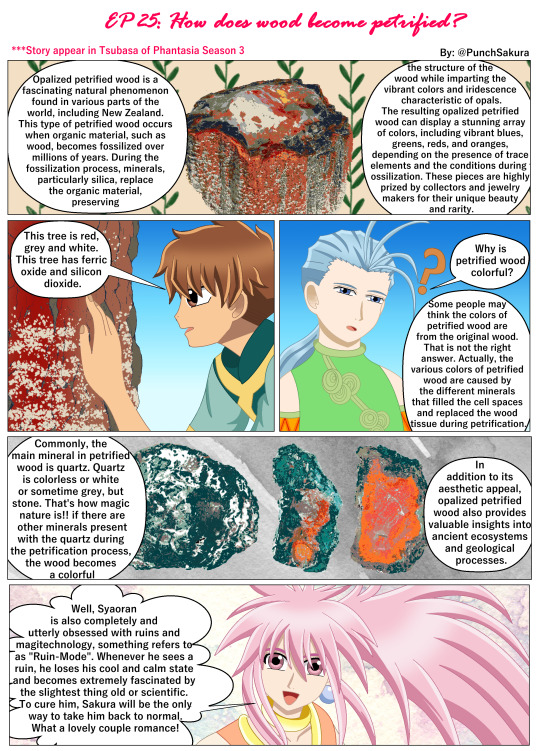
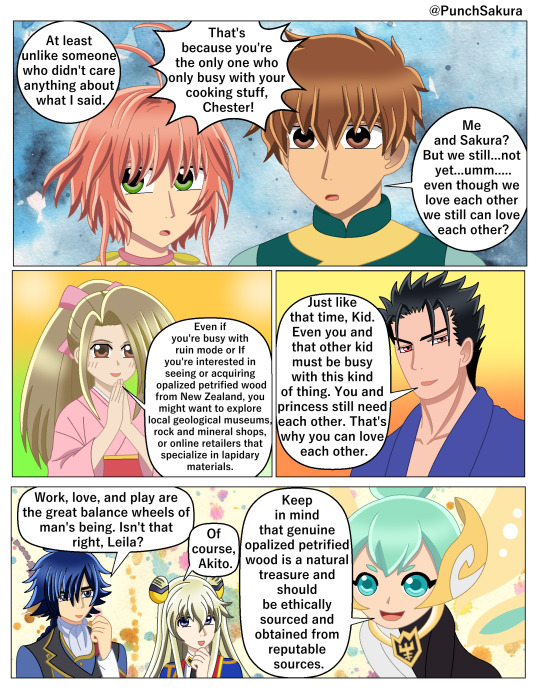
Knowledge 25
youtube
How to identify types of petrified wood?
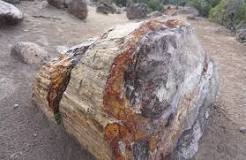
Petrified wood seen at Escalante Petrified Forest State Park. Petrified wood does not have a strict classification system. It is typically identified based on color and mineral composition. Depending on their oxidation state, trace metals, particularly iron, can produce a range of hues in petrified wood.
December 10, 2020Alison Cornford-Matheson
Petrified wood is an amazing stone. Its look can be quite distinct, featuring the same grain, rings, or other patterns found in wood without being made of organic materials. As a result, it’s a popular item for jewelry.
If you’d like to learn more about petrified wood, including what it is, how it’s made, and more, here’s what you need to know.
WHAT IS PETRIFIED WOOD?
Before we dig into what petrified wood is, let’s look at another question that often springs to mind: what does petrified mean? In the simplest terms, petrification is a process where organic matter changes into a stony substance. It’s not unlike ossification in the human body, where cartilage is turned into bone.
For something to be petrified, it needs to have gone through the process of petrification. As a result, petrified wood is simply wood (an organic material) that’s been changed into stone because of that process.
WHAT IS A PETRIFIED TREE?
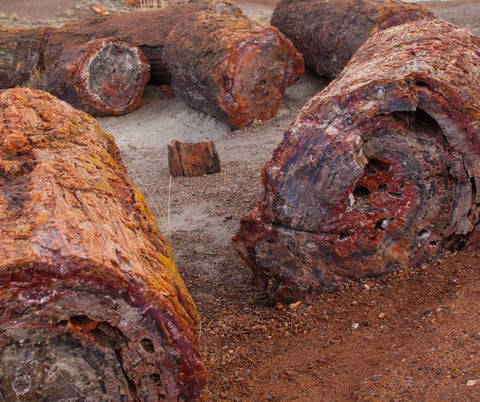
A petrified tree is just petrified wood. Usually, the only difference in those terms is the size of the piece being discussed. If it’s a large sample that still very much resembles a branch, trunk, or another clearly tree-like segment, it may be referred to as a petrified tree.
However, calling a large, tree-like specimen petrified wood isn’t incorrect. Similarly, referring to a smaller sample as a piece of a petrified tree isn’t wrong, either. It usually a matter of semantics.
HOW DOES WOOD BECOME PETRIFIED?
When it comes to what causes petrified wood, the process is relatively straightforward but rarely occurs. Typically, when a plant dies, it decomposes. For wood to petrify, that decomposition process can’t happen.
To end up with petrified wood, a dead tree or branch needs to be buried in the earth, such as under a layer of mud, silt, or even ash from a volcano. Once covered, oxygen can’t reach the organic matter, preventing or substantially slowing traditional decay.
Water with a high mineral content (or mineral-rich mud) also has to be present near the now-buried tree. As the fluid seeps into the wood’s structure through pores or similar openings, the organic form breaks down slowly. As it does, the physical structure is replaced by minerals, leading to petrified wood.
WHAT TYPE OF ROCK IS PETRIFIED WOOD?
In most cases, petrified wood contains silica, usually quartz. If you find a piece of agatized wood, it’s simply petrified wood that features agate, a type of chalcedony (which is actually a form of quartz).
With opalized petrified wood, it’s a bit trickier. While opalized wood can refer to petrified wood that’s made of opal, the term also covers any petrified wood that’s ended up with an opalescent sheen.
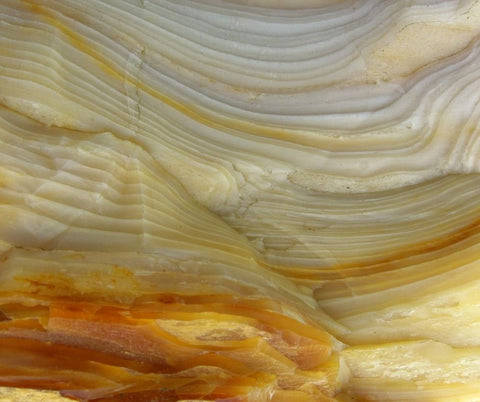
It’s also important to note that, with opalized petrified wood that actually contains opal, it’s usually common opal. Common opal does have a sheen, but it doesn’t have the characteristic play-of-color you typically find in precious opals (the version most frequently used for jewelry). As a result, opalized wood can actually look a lot like chalcedony petrified wood. In some cases, it even takes scientific testing to tell the difference.
However, there are petrified wood samples featuring precious opal. They are incredibly rare and tend to be more valuable than their counterparts.
IS PETRIFIED WOOD A FOSSIL?
Yes, petrified wood is a fossil. The process essentially preserves the structure of the original specimen while replacing the organic material with minerals.
#sakuraswordly#tsubasa of phantasia comic#tsubasa of phantasia knowledge#Tsubasa Li#Chester Burklight#Arche Klein#tsofph Season 3#Dio(top)#mel(top)#dio and mel#akito and leila#tsofph Season 1#princess tsubasa#sakura tsubasa#trc kurogane#Ethos#Suzu Fujibayashi#petrified wood#wood become petrified#opalized petrified wood#Youtube
0 notes
Text
Agatized corals are fossils formed when silica from groundwater replaces ancient buried corals (as opposed to typical calcite-replaced fossil corals). They consist of void fossils that have been filled with various forms of quartz (another name for silica), primarily one called chalcedony, and, in some cases, both chalcedony and rock crystal quartz (quartz that is clear with large visible crystals terminated by crystal faces). The term “agatized” refers to the variety of translucent chalcedony called “agate,” which has very small crystals (micro- or cryptocrystalline), and is characterized by banding and rich coloration, properties that are common to agates worldwide.
514 notes
·
View notes
Text
Oh, right, I never posted these! Here are the rocks I acquired at my last rock show!
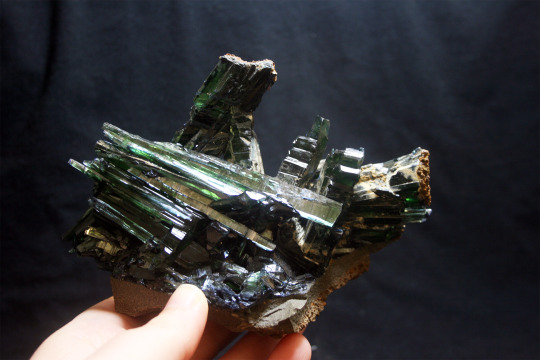
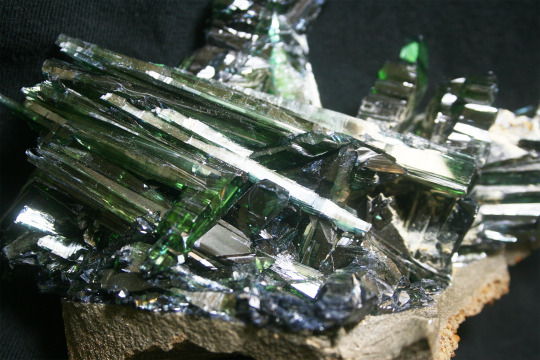
This big sparkly girl with the bottle green, glassy appearance is vivianite, a rock which is just as fragile as it looks! Vivianite has some really cool properties. It begins as a colorless mineral, but as soon as it’s exposed to light, it undergoes a chemical reaction that turns it this blue-green color. As long as it’s exposed to light, this chemical reaction will continue, and the crystals will turn darker and darker until they’re completely black. Another cool thing about vivianite is that it exhibits pleochroism, meaning the crystals look more green or more blue depending on the angle you view them at.
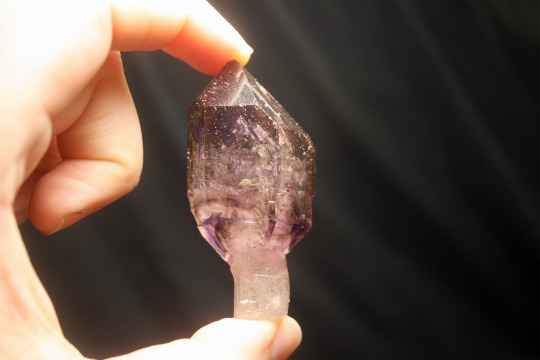
This funky-shaped sparkly girl is a scepter quartz! Scepter quartz occurs when a younger crystal begins growing on the tip of an older one, resulting in a big crystal perched atop a skinny one, like the jewel atop a scepter! This scepter is a smoky amethyst with some really cool stuff going on inside. My favorite detail is those red spots, which are caused by needle-like crystals of hematite growing inside the quartz!
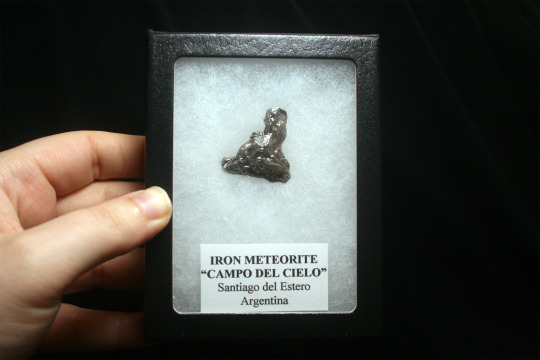
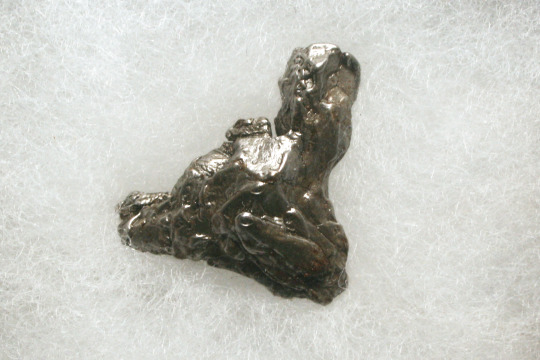
This is the third meteorite to join my collection! This piece fell to Earth about four to five thousand years ago in northern Argentina. Its melted appearance is because the heat of entering Earth’s atmosphere actually caused it to melt! Campo del Cielo meteorites are iron-nickel meteorites, made from a metal alloy called meteoric iron. (Ok, so, not to go off on a tangent but meteoric iron is really cool stuff, historically. See, iron doesn’t occur on planet Earth in its native, metallic form. It’s always bound up in ores and has to be processed. But native iron does occur in the vacuum of space, and sometimes that iron falls to Earth as meteors, so the only iron that Bronze Age people had access to before the advent of iron smelting was from meteors. They made some really cool stuff with it. Did you know that Tutankhamen was buried with a dagger made from meteoric iron?)
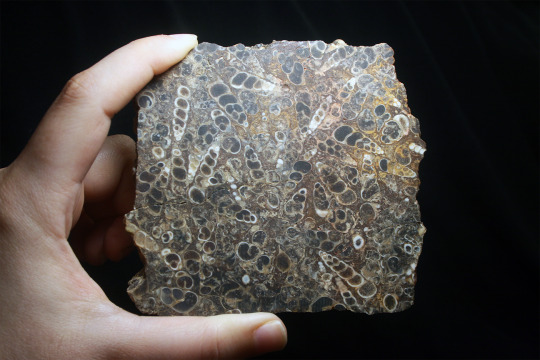
This fossil boy is a slab of turritella agate! It comes from a fossil deposit in Wyoming called the Green River Formation. Those white shapes are the fossilized shells of turritella sea snails encased in chert. These shells were once buried at the bottom of an ancient ocean! Because of the cool patterns their cross sections make, turritella slabs like this one are used by lapidary artists to cut cabochons for jewelry.

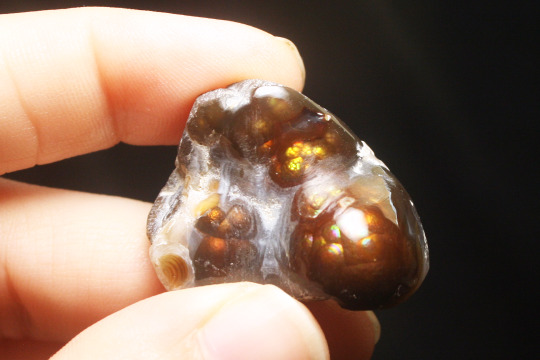
Speaking of cool agates, here’s a neat little fire agate! This piece came from the southwestern United States. That metallic, rainbow iridescence (or “fire”) is caused by alternating layers of goethite and limonite, which form as botryoidal bubbles encased in translucent chalcedony. Fire agate is one of the coolest forms of agate, because it’s so incredibly rare! The only place in the world where it’s found is an area from central Mexico up through California and Arizona, where it was formed during ancient volcanic activity.
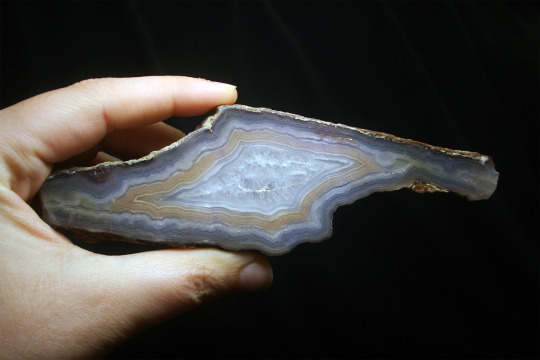
Here’s another cool agate! This is Aztec purple lace agate, which comes from Mexico. I don’t think they’re mining it out anymore (actually, it hasn’t been mined for a long time), so this is pretty scarce stuff! It doesn’t photograph well, so trust me when I say that this piece is much purpler in person. Other than that, I don’t know much about it!
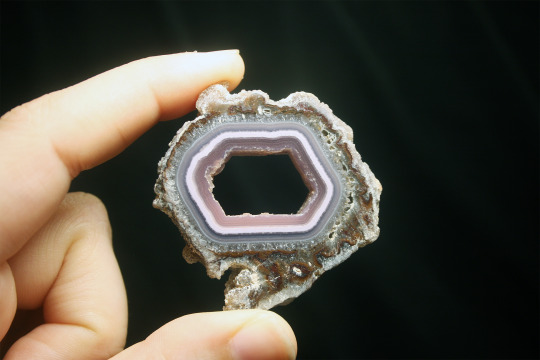
Also very purple and also from Mexico is this Coyamito agate! Note the super cool hexagon shape. Coyamito agate is known for its pseudomorph formations: it replaces other minerals and grows in their shape. That’s rare in agate, but super common in the Coyamito agate deposit! In this case, the agate was growing in the hollow left behind by a hexagonal crystal.
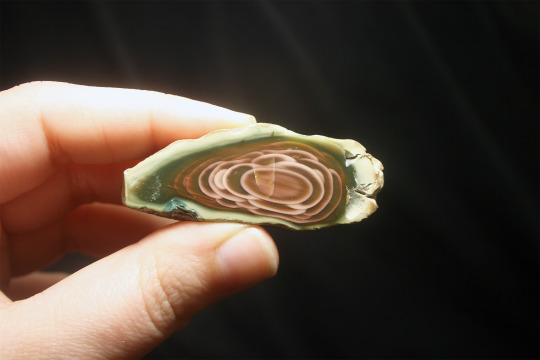
Here’s something I’ve been wanting to add to my collection for a long time! This dignified boy is royal imperial jasper, possibly my absolute favorite kind of jasper. (And unlike most of the rocks the crystal healing crowd likes to slap the word “jasper” on, he’s actually a real jasper!) We’re seeing in cross-section what’s known as an “egg” formation, the result of a jasper nodule which started small and then grew outward in uneven layers. Changes in the environment during the formation of each layer resulted in all these different colors! This piece is also from Mexico.
And finally (drumroll please), it’s time for opals! As is tradition, I came home from the show with three brand new Ethiopian opals. Here they are!
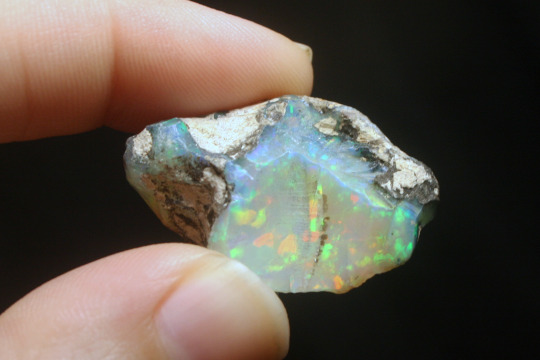
Opal number one! Beautiful! Subtle and refined! 10/10!

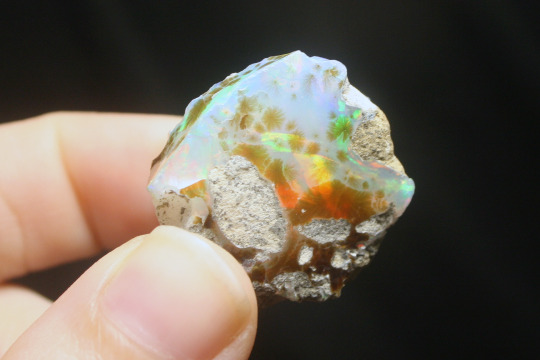
Opal number two! Stunning! A style all her own! Her birthmarks really add warmth and color to the overall presentation.
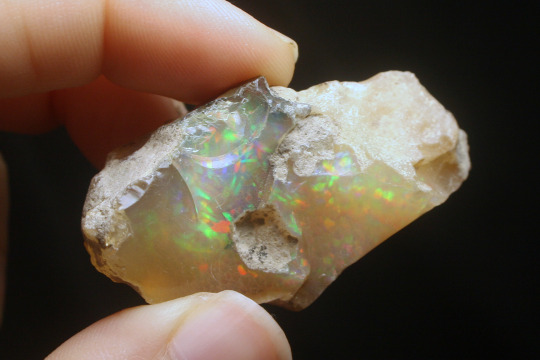
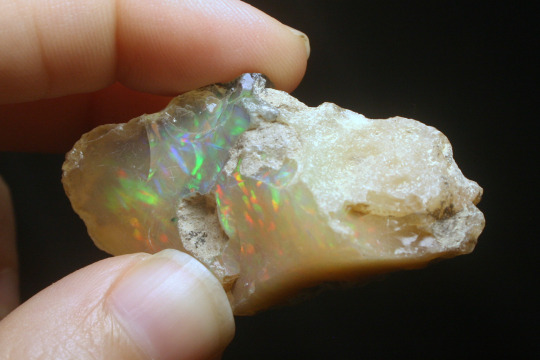
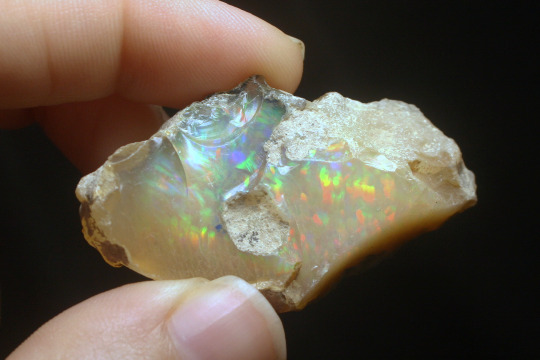
Opal number three, the Big Girl. Gorgeous! Full of fireworks! What a wonderful sparkly girl!
492 notes
·
View notes
Video
tumblr
fossilera
Here are some stunning chalcedony replaced gastropod fossils from Betul, India. They’ve been polished to reveal the once hollow cavity of the shell that has been filled with a pocket of beautiful druzy quartz crystals. They are also cut on one side so that they display nicely on a flat surface. These gastropod fossils are Cretaceous in age.
Follow the link in our bio or visit www.FossilEra.com and search for "gastropod quartz" to see similar items .
#gastropod#fossil#fossils#quartz#chalcedony#geology#betul#india#shell#fossilfriday#the earth story#instagram
221 notes
·
View notes
Photo

This is a stunning chalcedony replaced gastropod fossil from Betul, India. This specimen has been polished to reveal the once hollow cavity of the shell that has been filled with a pocket of beautiful druzy quartz crystals. While this particular specimen is sold, we still have quite a few others for sale at FossilEra.com
Image Source: https://www.fossilera.com/fossils/1-72-chalcedony-replaced-gastropod-with-druzy-quartz-india--2
273 notes
·
View notes
Text
Reasons why you should buy petrified wood furniture:
Petrified wood furniture gives the true essence of any home. It creates a spell to every soul around it. It offers vintage a classy look to your home. Whether you are decorating for a new home or just doing redecoration, petrified wood furniture will help to cover it all.

Petrified wood sculptures modified the rules of the home and made your room look like an art gallery. It presents an allure of any artist. Its unique and ancient look. Petrified wood is made up of fossils in which minerals replace the organic remains in the slow process of being replaced with stone. This process of petrification usually results in the mineralization of quartz chalcedony.
There is a variety of petrified wood furniture available in the market to decorate your home. Such as petrified wood sculptures, petrified wood coffee tables,
Let's talk about why you should buy petrified wood furniture:
It will feel like connecting to the human roots
A living example of life existence.
For a vintage look to your living place
Feel like a natural artisan
Rough but royal look
Different varieties available
Its robust body and anti-resistance properties.
Buy a Petrified wood Sculpture and become the talk of the town.
Truly natural
If you wish to create deep roots, associate with the petrified wood. Sticks and stones collection is going to help you. If you're filled with stress, anxiety, or terror, you'll be safe and grounded because of its soothing energies. The earth energies involved in it can still also relieve the nerves, as well as the fears. This can even fill you with feelings of warmth, protection, and stability.
Stick and Stones collections has a range of petrified wood furniture. Petrified wood products are ideal. You can meditate, as it can guide you in knowing what is and what is not essential. This can encourage you to stop obsessing about things you can't manage. It could also remind you to consider things the way they are, and not waste your energy on the little things.
#Petrified wood furniture#petrified wood sculptures#petrified wood coffee tables#furniture#tables#florida#usa
1 note
·
View note
Text
Dinosaur Bone Rings
Dinosaur Bone has been something that we have been working on with our shop for quite some time and we are very proud to have brought a unique and long-lasting product to market.
We use agatized dinosaur fossils for our dinosaur bone inlay rings. This type of fossil is a rare form of fossilized dinosaur bone where the original bone has been naturally replaced with silica-based compounds, such as agate, jasper, chalcedony, or opal. It can be traced back to dinosaurs that roamed the earth during the late Jurassic Age around 150 million years ago.
The formation of these Agatized fossils requires a particular type of environment to replace the calcite in the original fossils with silicates. For this to occur, local strata layers must be uplifted during tertiary intrusions so that silica-rich, superheated groundwater can flood these layers and force water and aqueous solutions into the microporous fossilized bone. It is this rare process that transpired on the Colorado Plateau 35 million years ago that created the beautifully patterned agatized dinosaur bone now used in our rings.
The highly agatized, uniquely patterned dinosaur bone used in our rings is found in the Four Corners region in the United States where Arizona, New Mexico, Utah and Colorado meet. The bulk of the dinosaur bone used in our rings were found in this area. In the United States, fossils are legal to own and distribute. A strict policy of ethics is followed to source the dinosaur bone. No material is collected from state or federal lands and no specimens are damaged in order to extract the gemstone inside.
While we use fossils that are too small or broken to be used in museums as showpieces, dinosaur bone looks like a typical rock, coming in a variety of sizes, until it is cut and polished. The different colors and patterns in agatized dinosaur bone are caused by minerals such as chlorite, chromium, iron-oxide and manganese that enter the cells during fossil formation making each piece truly one-of-a-kind.
Dinosaur bone is a fossil, fossil is a rock, and rock is brittle. This is why we inlay the dinosaur bone as a crushed inlay, rather than as an intact piece, ensuring a durable, wearable ring. The crushed pieces are inlaid into the groove of a band and sealed with a medical-grade resin. Lastly, the ring is sanded smooth and polished, giving it a final glossy appearance.
Dinosaur bone rings need no special care. These rings can be cleaned with regular jewelry cleaner.
Check out our wide range of Dinosaur Bone inlay rings today in our Dino Bone Collection.
2 notes
·
View notes
Text
History Of Turritella Agate

History Of Turritella Agate - Table of Contents - Introduction - The Ancient Origins of Turritella Agate - How Turritella Agate Was Used in Ancient Times - The Geology of Turritella Agate - The Different Types of Turritella Agate - The History of Turritella Agate Mining - The Cultural Significance of Turritella Agate - The Healing Properties of Turritella Agate - The Different Colors of Turritella Agate - The Uses of Turritella Agate in Jewelry - The History of Turritella Agate in Art - The Different Shapes of Turritella Agate - The History of Turritella Agate in Religion - The Different Varieties of Turritella Agate - The History of Turritella Agate in Medicine - The History of Turritella Agate in Folklore - Conclusion "Unlock the Ancient Mystery of Turritella Agate!" Introduction Turritella Agate is a unique and beautiful gemstone that has been around for centuries. It is a type of chalcedony, a form of quartz, and is characterized by its distinctive pattern of tightly-coiled fossilized shells. Turritella Agate is found in many places around the world, but is most commonly found in the United States, particularly in the western states of Utah, Wyoming, and Idaho. The history of Turritella Agate is fascinating, and it has been used for many different purposes throughout the centuries. This article will explore the history of Turritella Agate and its many uses. The Ancient Origins of Turritella Agate Turritella agate is a type of agate that is found in the fossilized shells of ancient sea creatures known as turritella. This type of agate is found in many parts of the world, including the United States, Mexico, and Europe. It is a popular gemstone for jewelry and other decorative items. The turritella species of sea creatures first appeared during the Cretaceous period, which was approximately 145 to 66 million years ago. These creatures were mollusks, and they had a long, spiral-shaped shell. The shells were made of calcium carbonate, which is the same material that makes up the shells of modern-day mollusks. As the turritella creatures died, their shells were buried in sediment and eventually fossilized. Over time, the calcium carbonate in the shells was replaced by silica, which is the same material that makes up agate. This process created the beautiful, colorful patterns that are seen in turritella agate today. The patterns in turritella agate are unique and can vary greatly from one piece to the next. The colors range from white to gray to brown, and the patterns can be stripes, swirls, or spots. The patterns are created by the different minerals that were present in the sediment when the shells were fossilized. Turritella agate is a beautiful and unique gemstone that has been around for millions of years. It is a reminder of the ancient creatures that once roamed the seas and a testament to the power of nature. How Turritella Agate Was Used in Ancient Times Turritella agate is a type of fossilized agate that is composed of the shells of ancient sea snails known as Turritella. This type of agate has been used for centuries in jewelry and other decorative items. In ancient times, Turritella agate was used for a variety of purposes. It was believed to have protective powers and was often used as an amulet or talisman. It was also believed to bring good luck and was used as a charm to ward off evil spirits. Turritella agate was also used in jewelry making. It was often used to make rings, necklaces, and other pieces of jewelry. The agate was also used to make beads and other decorative items. In addition to its use in jewelry, Turritella agate was also used in the creation of tools and weapons. It was believed to be a strong and durable material and was used to make arrowheads, spearheads, and other tools. Turritella agate was also used in religious ceremonies. It was believed to have spiritual powers and was used in rituals and ceremonies to bring good luck and protection. Today, Turritella agate is still used in jewelry making and other decorative items. It is also used in the creation of tools and weapons. It is a popular material for collectors and is often used in the creation of unique and beautiful pieces of art. The Geology of Turritella Agate Turritella agate is a type of agate that is found in the fossilized shells of ancient marine creatures known as turritella. It is a type of chalcedony, a form of quartz, and is characterized by its distinctive spiral pattern. Turritella agate is found in sedimentary rocks, such as limestone and shale, that were formed in shallow marine environments. The fossilized shells of the turritella are found in these rocks, and the agate forms around them. The agate is formed when silica-rich groundwater seeps into the sedimentary rocks and deposits silica around the fossilized shells. Over time, the silica deposits form a hard, translucent layer of agate around the shells. The distinctive spiral pattern of turritella agate is caused by the shape of the turritella shells. The shells are coiled in a spiral pattern, and the agate forms around them in the same pattern. The agate is usually a creamy white color, but can also be found in shades of yellow, brown, and gray. Turritella agate is a popular gemstone, and is used in jewelry and other decorative items. It is also believed to have healing properties, and is used in some forms of alternative medicine. Turritella agate is found in many parts of the world, including the United States, Mexico, and Europe. It is a relatively common type of agate, and can be found in many rock and gem shops. The Different Types of Turritella Agate Turritella agate is a type of agate that is found in many parts of the world. It is a type of fossilized shell that is composed of a variety of different types of shells. The most common type of Turritella agate is the one found in the Green River Formation in Wyoming, USA. This type of agate is characterized by its distinctive pattern of tightly packed, spiral-shaped shells. Turritella agate can be found in a variety of colors, including white, gray, brown, and black. The most common type of Turritella agate is the one found in the Green River Formation, which is usually a light gray or white color. This type of agate is often used in jewelry and other decorative items. There are several different types of Turritella agate. The most common type is the one found in the Green River Formation, which is characterized by its tightly packed, spiral-shaped shells. This type of agate is often used in jewelry and other decorative items. Another type of Turritella agate is the one found in the Morrison Formation in Utah, USA. This type of agate is characterized by its large, round shells and is usually a darker color than the Green River Formation agate. This type of agate is often used in jewelry and other decorative items. The third type of Turritella agate is the one found in the Hell Creek Formation in Montana, USA. This type of agate is characterized by its large, flat shells and is usually a darker color than the Green River Formation agate. This type of agate is often used in jewelry and other decorative items. Finally, the fourth type of Turritella agate is the one found in the Bearpaw Formation in Alberta, Canada. This type of agate is characterized by its small, round shells and is usually a lighter color than the Green River Formation agate. This type of agate is often used in jewelry and other decorative items. No matter which type of Turritella agate you choose, it is sure to add a unique and beautiful touch to any piece of jewelry or decorative item. Each type of Turritella agate has its own unique characteristics and can be used to create a variety of different looks. The History of Turritella Agate Mining Turritella agate is a type of agate that is found in the Green River Formation in Wyoming, USA. It is a sedimentary rock composed of fossilized shells of the freshwater snail, Turritella. The agate is characterized by its unique pattern of swirls and bands, which are created by the fossilized shells. The mining of Turritella agate began in the late 1800s, when miners discovered the agate in the Green River Formation. The agate was initially mined for its ornamental value, as it was used to make jewelry and other decorative items. The agate was also used to make cabochons, which are polished stones used in jewelry making. In the early 1900s, the mining of Turritella agate increased significantly. This was due to the discovery of a large deposit of the agate in the Green River Formation. The agate was mined in large quantities and shipped to various parts of the United States and Europe. The mining of Turritella agate continued until the mid-1900s, when the demand for the agate began to decline. This was due to the introduction of synthetic materials, which were cheaper and easier to produce than the natural agate. As a result, the mining of Turritella agate decreased significantly. Today, Turritella agate is still mined in the Green River Formation, but in much smaller quantities than before. The agate is still used to make jewelry and other decorative items, but it is no longer as popular as it once was. Despite this, Turritella agate remains a popular choice for collectors and those who appreciate its unique beauty. The Cultural Significance of Turritella Agate Turritella agate is a type of agate that is found in the fossilized shells of ancient sea creatures called turritella. It is a type of chalcedony, a mineral composed of silicon dioxide, and is characterized by its unique pattern of swirls and bands. Turritella agate is found in many parts of the world, including the United States, Mexico, and Brazil. Turritella agate has been used for centuries in jewelry and other decorative items. It is believed to have been used by the ancient Egyptians, who carved it into amulets and other objects. In the Middle Ages, it was used to make rosaries and other religious items. Turritella agate has also been used in the making of jewelry, such as rings, necklaces, and earrings. Turritella agate has a long history of being associated with spiritual and healing properties. It is believed to be a powerful stone that can help to bring balance and harmony to the wearer. It is also believed to be a stone of protection, helping to ward off negative energy and protect the wearer from harm. Turritella agate is also believed to be a stone of luck and good fortune. It is said to bring good luck to those who wear it, and to bring prosperity and success. It is also believed to be a stone of love and friendship, helping to bring people together and strengthen relationships. Turritella agate is a beautiful and unique stone that has been used for centuries in jewelry and other decorative items. It is believed to have spiritual and healing properties, and to bring luck, prosperity, and protection to the wearer. It is a stone that has been treasured for centuries, and its cultural significance is still strong today. The Healing Properties of Turritella Agate Turritella Agate is a type of agate that is found in the fossilized shells of ancient sea creatures. It is a type of chalcedony, which is a form of quartz. This stone is known for its healing properties and is believed to be a powerful aid in spiritual and emotional healing. Turritella Agate is said to be a powerful stone for connecting with the Earth and its ancient energies. It is believed to help one to access the wisdom of the past and to gain insight into one’s own life. It is also said to be a powerful aid in connecting with one’s ancestors and to gain insight into one’s family history. This stone is believed to be a powerful aid in emotional healing. It is said to help one to release old patterns of behavior and to open up to new possibilities. It is also said to help one to find inner strength and to be more open to change. Turritella Agate is also believed to be a powerful aid in physical healing. It is said to help to reduce inflammation and to promote healing of the body. It is also said to help to reduce stress and to promote relaxation. Turritella Agate is a powerful stone for spiritual healing. It is said to help one to connect with the divine and to open up to spiritual guidance. It is also said to help one to access higher levels of consciousness and to gain insight into one’s spiritual path. Turritella Agate is a powerful stone for healing and transformation. It is said to help one to access ancient wisdom and to gain insight into one’s life. It is also said to be a powerful aid in emotional and physical healing, as well as spiritual healing. The Different Colors of Turritella Agate Turritella agate is a type of agate that is found in the fossilized shells of ancient sea creatures. It is a unique and beautiful stone that is prized for its unique patterns and colors. The colors of Turritella agate range from light brown to dark brown, with some specimens having shades of red, yellow, and even green. The most common color of Turritella agate is a light brown, which is caused by the presence of iron oxide in the stone. This color is often referred to as “tiger eye” and is the most popular color of Turritella agate. The light brown color is often accompanied by darker brown or black stripes, which are caused by the presence of manganese oxide. The second most common color of Turritella agate is a deep red. This color is caused by the presence of hematite, which is an iron oxide. The red color is often accompanied by lighter shades of red, orange, and yellow. The third most common color of Turritella agate is a yellowish-green. This color is caused by the presence of chromium oxide. The yellowish-green color is often accompanied by lighter shades of green, yellow, and even blue. The fourth most common color of Turritella agate is a blue-green. This color is caused by the presence of copper oxide. The blue-green color is often accompanied by lighter shades of blue, green, and even purple. Turritella agate is a beautiful and unique stone that is prized for its unique patterns and colors. The colors of Turritella agate range from light brown to dark brown, with some specimens having shades of red, yellow, and even green. No matter what color of Turritella agate you choose, it is sure to be a beautiful addition to any collection. The Uses of Turritella Agate in Jewelry Turritella agate is a type of gemstone that is highly sought after for its unique and beautiful appearance. It is a type of chalcedony, a form of quartz, and is characterized by its distinctive pattern of fossilized shells. This gemstone is often used in jewelry, as it is both attractive and durable. Turritella agate is found in a variety of colors, ranging from light brown to dark green. The fossilized shells that give the stone its unique pattern are usually white or cream-colored. The pattern of the shells is often quite intricate, making it a very attractive stone for jewelry. Turritella agate is a very durable stone, making it ideal for use in jewelry. It is resistant to scratches and other damage, and it is also quite hard, making it difficult to break. This makes it a great choice for rings, necklaces, and other pieces of jewelry that may be subject to wear and tear. The unique pattern of Turritella agate makes it a great choice for jewelry. It can be used to create a variety of different looks, from classic and elegant to modern and edgy. The stone can be cut into a variety of shapes and sizes, allowing for a wide range of design possibilities. Turritella agate is also a great choice for those looking for a unique and special piece of jewelry. The fossilized shells give the stone a unique and interesting look that is sure to draw attention. It is also a great choice for those looking for a piece of jewelry that is both beautiful and durable. Turritella agate is a great choice for those looking for a unique and beautiful piece of jewelry. Its unique pattern and durability make it a great choice for a variety of different pieces of jewelry. Whether you are looking for a classic and elegant piece or a modern and edgy one, Turritella agate is sure to make a great addition to any jewelry collection. The History of Turritella Agate in Art Turritella agate is a type of agate that is found in the fossilized shells of ancient sea creatures. It is characterized by its unique pattern of swirls and bands, which are created by the fossilized shells of the ancient creatures. This type of agate has been used in art for centuries, and its unique pattern has been used to create beautiful and intricate pieces of art. The use of Turritella agate in art dates back to ancient times. In ancient Egypt, Turritella agate was used to create jewelry and other decorative items. The Egyptians believed that the unique pattern of the agate was a sign of protection and good luck. The agate was also used to create amulets and other items that were believed to bring good luck and protection. In the Middle Ages, Turritella agate was used to create religious artifacts. It was believed that the unique pattern of the agate was a sign of divine protection and was used to create religious symbols and images. The agate was also used to create jewelry and other decorative items. In the Renaissance period, Turritella agate was used to create beautiful pieces of art. The unique pattern of the agate was used to create intricate designs and patterns. The agate was also used to create sculptures and other decorative items. Today, Turritella agate is still used in art. It is used to create jewelry, sculptures, and other decorative items. The unique pattern of the agate is still used to create beautiful and intricate pieces of art. The agate is also used to create amulets and other items that are believed to bring good luck and protection. Turritella agate is a beautiful and unique type of agate that has been used in art for centuries. Read the full article
#astrology#chakra#clairvoyant#clarity#Cleansing#cleansingcrystals#conscious#courage#crystalballs#crystalgrids#crystalhealing#crystallove#crystalmagic#crystalpower#crystalreiki#crystalshop#crystalshops#crystalstore#crystaltarot#crystalsandstones#crystalsbyrob#crystalsforsale#crystalssaltlakecity#crystalsUtah#divination#divinationtools#energyhealing#esotericshop#esotericstore#esotericsupplies
0 notes
Photo

Woodn't you love to see our new selection of Petrified wood? Some with beautiful chalcedony, and druzy quartz. What exactly is petrified wood, and why is it scared? Petrified Wood forms when plant material is buried by sediment and protected from decay due to oxygen and organisms. Then, groundwater rich in dissolved solids flows through the sediment, replacing the original plant material with silicate minerals. The result is a fossil of the original woody material that often exhibits preserved details of the bark, wood, and cellular structures. Petrified wood fears nothing.😅 - - #petrifiedwood #wood #nature #crystals #minerals #gems #jadesgems #jadesgemshop #druzy #chalcedony #botryoidal (at Scranton, Pennsylvania) https://www.instagram.com/p/Ccd4HWAu6s1/?igshid=NGJjMDIxMWI=
#petrifiedwood#wood#nature#crystals#minerals#gems#jadesgems#jadesgemshop#druzy#chalcedony#botryoidal
0 notes
Text
How to Get Best Furniture & Tableware Items Manufacturing Company?
We would like to introduce ourselves as the Manufacturer cum Exporter of semi-precious stones various products, which specialize in furniture & decorative products.
At Progressive Design, we will work together with you, as well as with any other professional involved. Our aim is to ensure we always get the best results. We build trust from the get-go and breathe life into the vision of your New Home. We engage with our clients and ensure we understand their concept and way of living before we start a project.
By laying the groundwork from the start, it builds up our confidence that what we produce is fully aligned with what you want and envision. Any challenges coming along the way can always be overcome by collaborating in problem solving.
Our Collections are Fossil, Jasper, Obsidian, Agate, Quartz, Amber Shells, Minerals, Carnelian, Aventurine, Labradorite, Tiger Eye & Varied.
Fossil Types: We have Bianco Petrified Wood, Fossilized Ammonite, Petrified Wood, Porto Petrified Wood & Retro Petrified Wood. The stone is a powerful karmic cleanser. It converts negative energy into a gently flowing positive spiral. It stimulates survival instincts. If kept in home, it will bring wealth, health, vitality and happiness. If placed in the business premises it will promote beneficial business dealings. When worn, ammonite will impart charisma and sensuous beauty to the wearer.
It is helpful for overall wellbeing and longevity, depression, labor pains, cell metabolism, osteomyelitis and tinnitus. Ammonite awakens Kundalini energy and cellular memory. It stabilizes the pulse and overcomes degenerative disorders. It supports the cranium and inner ear, lungs and limbs.
Jasper: Black Jasper, Red Jasper & Yellow Jasper. Jasper is an aggregate of micro granular quartz and chalcedony and other mineral phases. It is an opaque, impure variety of silica, usually red, yellow, brown or green in color and rarely blue. It is a beautiful stone used for ornamentation and as a gemstone. Jasper is known for its healing property as “supreme nurturer”. It sustains and supports through times of stress, and brings tranquility and wholeness. Jasper provides protection and absorbs negative energy. It balances yin and yang. Jasper clears electromagnetic and environmental pollution, including radiation. It encourages honesty with one's self. Provides courage to assertively tackle problems and aids quick-thinking. It supports during prolonged illness and re-energizes the body.
Obsidian: Black Obsidian, Golden Black Obsidian, Silver Black Obsidian & Smoky Obsidian. This stone awakens the inner warrior and provides courage to enter our subconscious mind and rediscover our hidden abilities. Obsidian, in general, protects our mind from all sorts of negative energies. Because of its reflective, mirror-like surface, Obsidian works like a mirror in which we can clearly see our own mistakes and weaknesses. Moreover, this stone will provide assistance and insight into the possible ways of correcting those mistakes. Obsidian is also believed to block the empathogenic radiation.
Agate: Grey Agate, Brown Agate, White Agate, Blue Agate, Exotic Agate, Black Agate, Red Agate, Rainbow Agate & Blue Lace Agate. It is used as a semiprecious stone when it is of desirable quality and color. Agate generally forms by the deposition of silica from groundwater in the cavities of igneous rocks.
Quartz: White Quartz, Rose Quartz, Smokey Quartz, Yellow Quartz & Rainbow Quartz. Quartz crystals maintain a precise frequency standard, which helps to regulate the movement of a watch or clock, thus making the timepieces very accurate
Amber Shells: Bronze mother of pearl, Black mother of pearl, Golden mother of pearl, White mother of pearl, Belone & Caramel Abalone. Amber is a fossilized resin from extinct coniferous trees. Amber is a purifier, acting on the energetic, emotional and physical levels. Amber is fossilized tree resin, which has been appreciated for its color and natural beauty since Neolithic times. Much valued from antiquity to the present as a gemstone, amber is made into a variety of decorative objects. Amber is used as an ingredient in perfumes, as a healing agent in folk medicine, and as jeweler.
Minerals: Pyrite Silver & Brown Carnelian. Carnelian Types: Black Carnelian & Brown Carnelian. Mineral” is not the first thing to come to mind when you hear the word “beauty,” and that’s a pity because they look so, so pretty. A mineral is a naturally occurring chemical compound, usually of crystalline form and abiogenic in origin. A mineral has one specific chemical composition, whereas a rock can be an aggregate of different minerals or mineraloids. The silicate minerals compose over 90% of the Earth's crust.
Aventurine: Green Aventurine & Apricot Aventurine. Aventurine stones are crystals that contain a good amount of quartz in them, along with inclusions of various other minerals. Aventurine is known as the “Stone of Opportunity,” thought to be the luckiest of all crystals, especially in manifesting prosperity and wealth, or for increasing favor in competitions or games of chance.
Labradorite Types: Electric Blue Labradorite & Peacock Blue Labradorite. Aventurine stones are crystals that contain a good amount of quartz in them, along with inclusions of various other minerals. Aventurine is known as the “Stone of Opportunity,” thought to be the luckiest of all crystals, especially in manifesting prosperity and wealth, or for increasing favor in competitions or games of chance.
Tiger Eye: Blue tiger eye, Gold Tiger Eye & Red Tiger Eye. Tigers Eye Stone is a crystal with lovely bands of yellow-golden color through it. This is a powerful stone that aids harmony and balance. Tiger's eye (also called Tiger’s eye or Tiger eye) is a chatoyant gemstone that is usually a metamorphic rock that is a golden to red-brown color, with a silky luster. A member of the quartz group, it is a classic example of pseudomorphs replacement by silica of fibrous crocidolite (blue asbestos).
Varied: It stimulates taking action, and helps you to make decisions with discernment and understanding, and unclouded by your emotions. Lapis lazuli, Amethyst, Green Jade, Calcite Blue, Hematite, Fluorite, Blue Apatite & Amazonite.
Our Manufactured Products are Coaster, Platter, Boxes, Home Décor Products, Mirrors, Tables, Wash Basin & Stone Products.
For More Information visit: http://www.agatesnstones.com/
0 notes